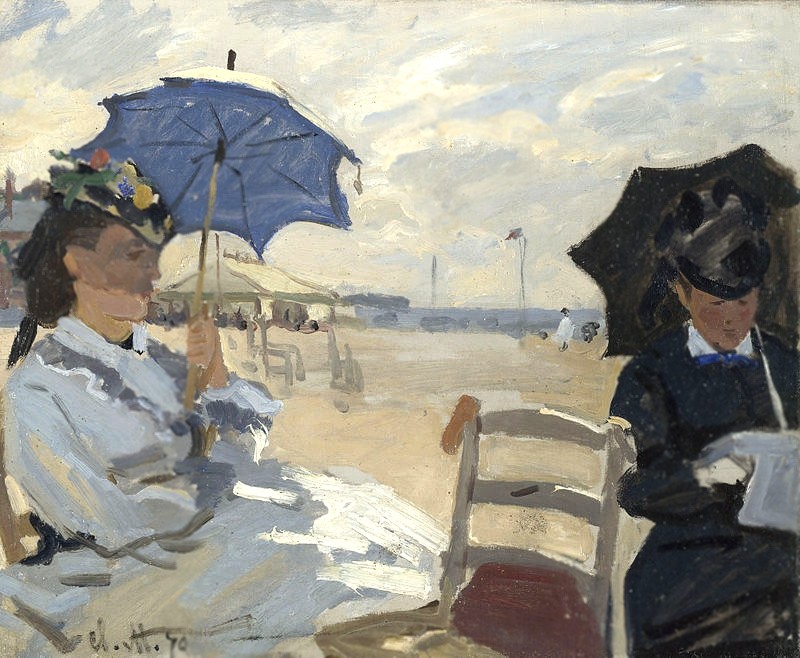CLAUDE MONET
Dejeuner surl herbe
CLAUDE MONET
Women in the Garden
CLAUDE MONET
Madame Monet en costume japonais
CLAUDE MONET
Springtime 1872.
CLAUDE MONET
La plage de Trouville, 1870.
CLAUDE MONET
Jean Monet on his Hobby Horse

CLAUDE MONET
1840 - 1926
BIOGRAPHY
Claude Monet: Painter Born: November 14,
1840 in Paris, France
Died: December 5, 1926
Claude Monet was born on November 15, 1840
in Paris, but his family moved to the port
city of Le Havre, France while he was still
young. He loved to draw as a child. He began
drawing caricatures of people that were quite
good. Even as a kid he was able to make some
extra money drawing pictures of people. Around
the age of eleven, Claude entered a school
for the arts. His mother supported his becoming
an artist, but his father wanted him to take
over the family grocery business. Claude
met some other artists around this time and
began to use oil paints to paint the outdoors.
Moving to Paris A few years after his mother
died in 1857, Claude moved to Paris to study
art at the Academie Suisse. He was there
for about a year when he was drafted into
the army. He became sick with typhoid fever
in the army and returned home a few years
later. Women in the Garden Monet continued
to paint outdoor scenes. His paintings were
becoming accepted by the art critics in Paris.
He then decided to take on large project
he called Women in the Garden. This was a
huge painting, over eight feet tall, that
he painted outside in the natural light.
It was a normal everyday scene. He spent
a lot of time on it, but the critics did
not like it. He became depressed and was
also out of money. London War broke out in
France in 1870 and Claude moved with is new
wife, Camille, to London. There he met art
dealer Paul Durand-Ruel who would become
one of his strongest supporters. At this
time Monet began to study the relation of
the city of London to the River Thames. Impressionists
Monet became friends with several of the
leading artists of the time including Pierre
Renoir, Edouard Manet, and Camille Pissarro.
Together they formed the Society of Anonymous
Painters, Sculptors, and Printers. They wanted
to experiment with art and not do the same
classical art that satisfied the art critics
of Paris. They organized an exhibition of
their art in 1874. One critic called it the
Exhibition of the Impressionists. The term
"impressionist" was used to imply
that the art was just an impression of something
and not completed. It was meant as an insult.
Impression: Sunrise The critic got the word
"impression" from one of Monet's
works. It is called Impression: Sunrise.
This painting was a great example of the
new style. The lighting gives the viewer
the feeling or "impression" that
the sun is just rising. Monet's use of light
was unique. An interesting fact about this
picture is the brightness of the sun. It
is the same as the sky. If you turn this
picture into a black and white picture, the
sun virtually disappears.
The Post-Impressionism
Post-Impressionism in Western painting, movement
in France that represented both an extension
of Impressionism and a rejection of that
style's inherent limitations. The term Post-Impressionism
was coined by the English art critic Roger
Fry for the work of such late 19th-century
painters as Paul Cézanne, Claude Monet, Georges
Seurat, Paul Gauguin, Vincent van Gogh, Henri
de Toulouse-Lautrec, and others. All of these
painters except van Gogh were French, and
most of them began as Impressionists; each
of them abandoned the style, however, to
form his own highly personal art. Impressionism
was based, in its strictest sense, on the
objective recording of nature in terms of
the fugitive effects of colour and light.
The Post-Impressionists rejected this limited
aim in favour of more ambitious expression,
admitting their debt, however, to the pure,
brilliant colours of Impressionism, its freedom
from traditional subject matter, and its
technique of defining form with short brushstrokes
of broken colour. The work of these painters
formed a basis for several contemporary trends
and for early 20th-century modernism.
The Post-Impressionists often exhibited together,
but, unlike the Impressionists, who began
as a close-knit, convivial group, they painted
mainly alone. Cézanne painted in isolation
at Aix-en-Provence in southern France; his
solitude was matched by that of Paul Gauguin,
who in 1891 took up residence in Tahiti,
and of van Gogh, who painted in the countryside
at Arles. Both Gauguin and van Gogh rejected
the indifferent objectivity of Impressionism
in favour of a more personal, spiritual expression.
After exhibiting with the Impressionists
in 1886, Gauguin renounced "the abominable
error of naturalism." With the young
painter Émile Bernard, Gauguin sought a simpler
truth and purer aesthetic in art; turning
away from the sophisticated, urban art world
of Paris, he instead looked for inspiration
in rural communities with more traditional
values. Copying the pure, flat colour, heavy
outline, and decorative quality of medieval
stained glass and manuscript illumination,
the two artists explored the expressive potential
of pure colour and line, Gauguin especially
using exotic and sensuous colour harmonies
to create poetic images of the Tahitians
among whom he would eventually live. Arriving
in Paris in 1886, the Dutch painter van Gogh
quickly adapted Impressionist techniques
and colour to express his acutely felt emotions.
He transformed the contrasting short brushstrokes
of Impressionism into curving, vibrant lines
of colour, exaggerated even beyond Impressionist
brilliance, that convey his emotionally charged
and ecstatic responses to the natural landscape.
In general, Post-Impressionism led away from
a naturalistic approach and toward the two
major movements of early 20th-century art
that superseded it: Cubism and Fauvism, which
sought to evoke emotion through colour and
line.
THE POSTIMPRESSIONISM
IN ARTE EST LIBERTAS
MOVEMENTS-ARTISTS








